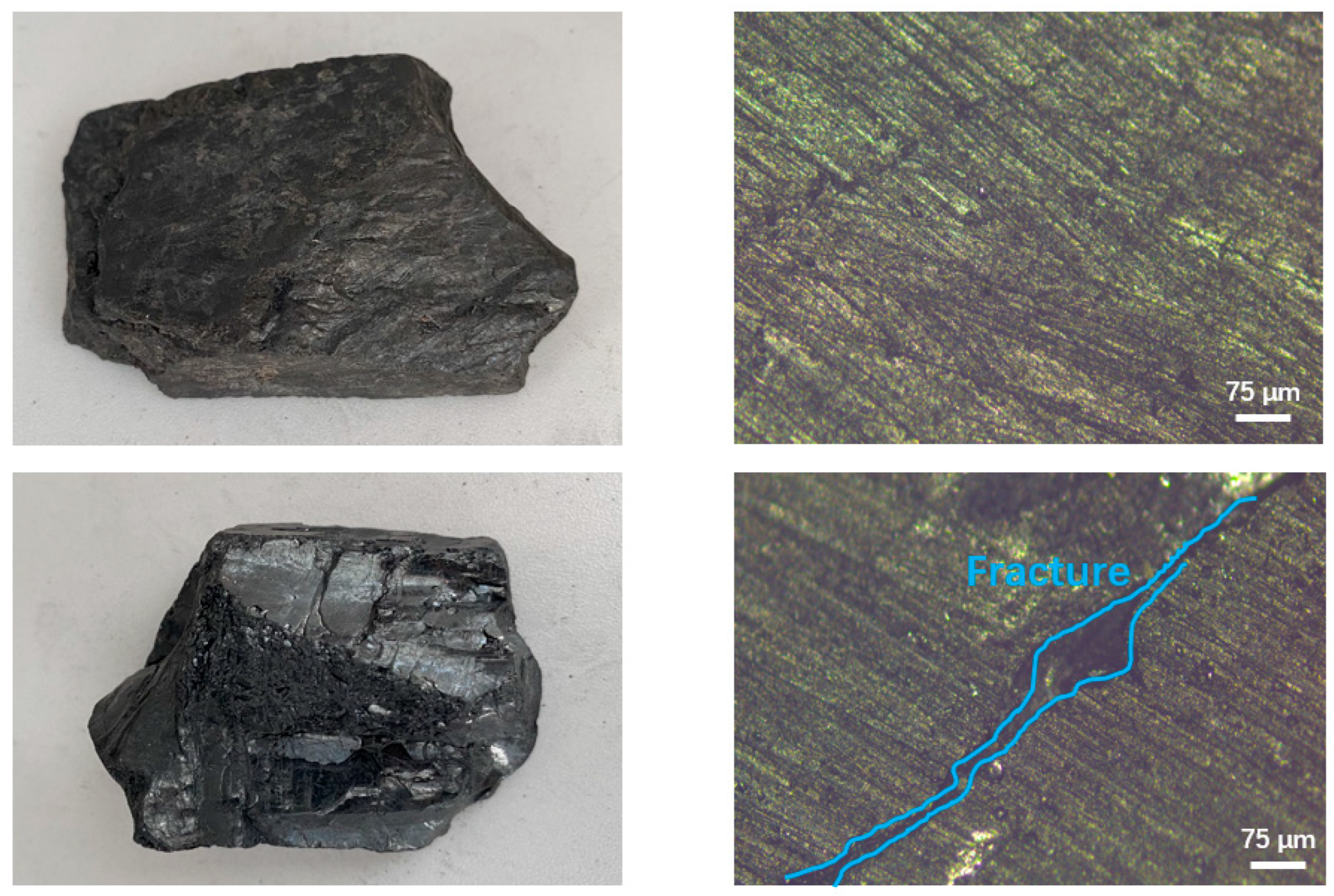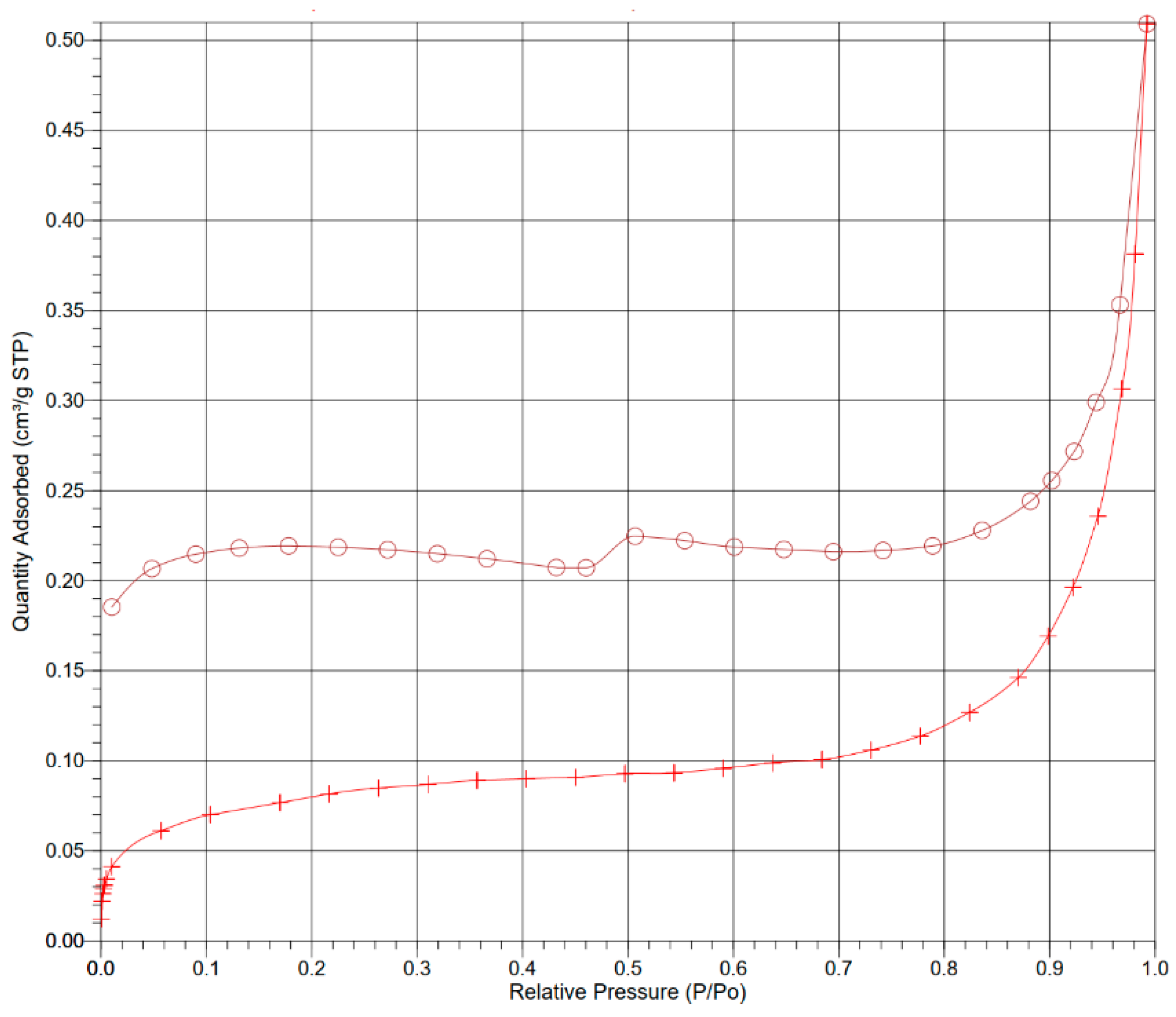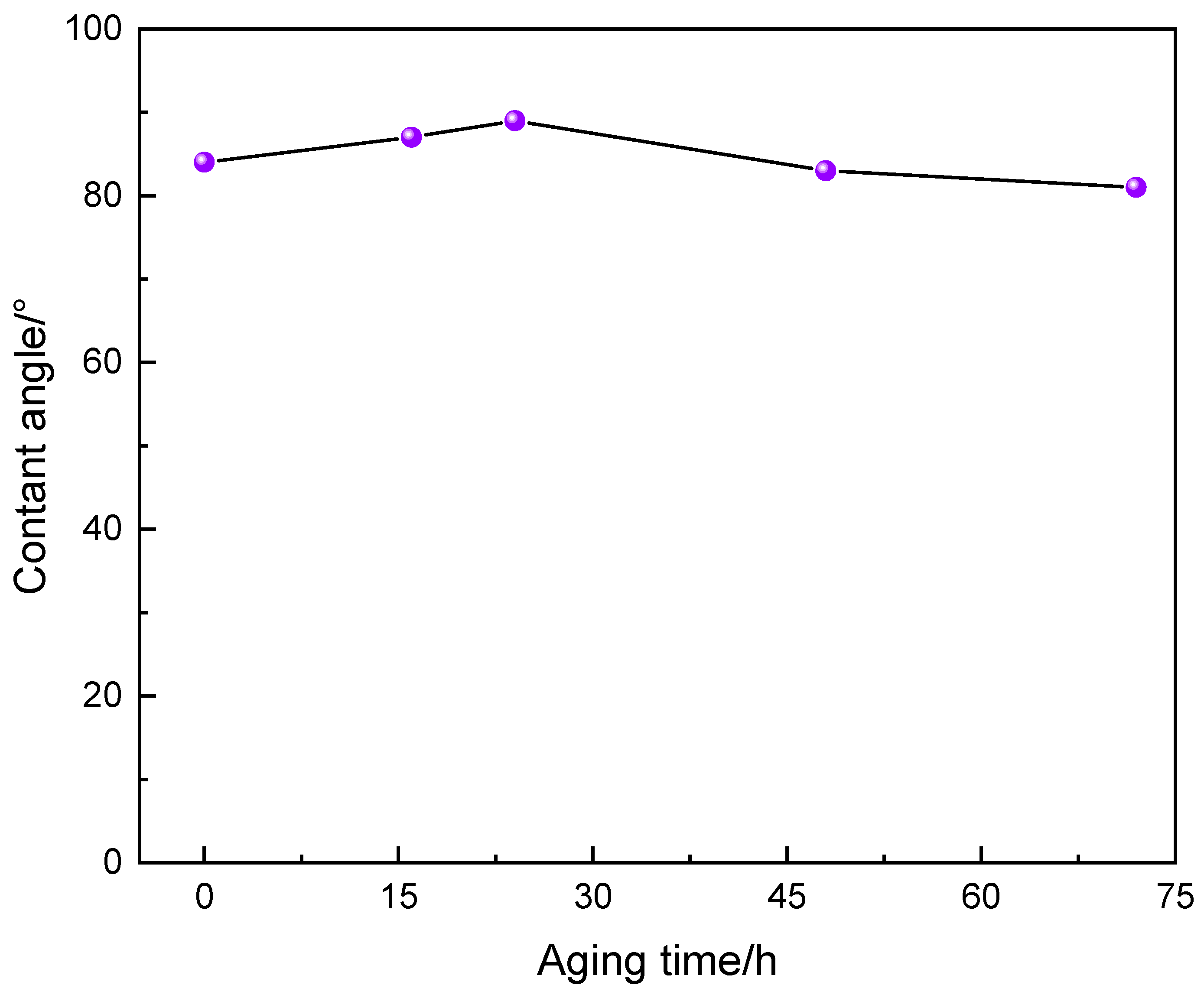Study on Wellbore Instability Mechanism and High-Performance Water-Based Drilling Fluid for Deep Coal Reservoir
Abstract
1. Introduction
2. Experimental Section
2.1. Materials
2.2. Characterization
- (1)
- Contact Angle Experiment
- (2)
- Core Microstructure Characterization
- (3)
- Triaxial Mechanical Experiment
- (4)
- Sand-Bed Plugging Experiment
3. Results and Discussion
3.1. The Physical Property Analysis of Deep Coal Reservoir
- (1)
- The clay mineral analysis of deep coal sample
- (2)
- The BET analysis of deep coal sample
- (3)
- The wettability evaluation of deep coal formation
3.2. Wellbore Instability Mechanism of Deep Coal Rock Reservoir
- (1)
- Effect of drilling fluid on coal surface morphology
- (2)
- Effect of Drilling Fluid on the Mechanical Properties of Coal Rock
3.3. Synthesis and Evaluation of Nano Plugging Agent
- (1)
- The design of nano plugging agent
- (2)
- Tensile strength test
- (3)
- Surface Morphology Analysis Before and After Plugging
3.4. Evaluation of Anti-Collapsing Drilling Fluid
- (1)
- Rheological properties of the anti-collapsing drilling fluid
- (2)
- Impact of anti-collapsing drilling fluid on the coal wettability
- (3)
- Sealing performance of wellbore-stabilizing drilling fluid
4. Conclusions
- (1)
- The coal rock is prone to collapse under the interaction of drilling fluids. The amorphous minerals within the pore throats would dissolve once contact is made with drilling fluid, leading to a reduction in the local structural integrity of the coal rock. The radius of the pore throat is small, leading to a strong capillary force, and then the external fluid that can be imbibed into the coal rock becomes more difficult to flow back, further reducing the strength of the coal rock.
- (2)
- The prepared nano-plugging anti-collapse agent can effectively cement coal particles and fracture to stabilize the wellbore. The tensile strength of the coal briquettes increased to 2.27 MPa after being treated with the anti-collapse agent solution. The mechanism of the agent is that the nano-plugging anti-collapse agent forms a dense layer on the coal surface by sealing micropores and microcracks, and the adsorption layer can cement coal particles together. Hence, the hydration swelling of clay in the wellbore region can be effectively suppressed. Additionally, the plugging layer decreased stress transfer within the borehole wall and prevented the borehole collapse caused by stress concentration.
- (3)
- The drilling fluid for deep coal rock reservoirs was constructed, which exhibits excellent plugging and collapse prevention performance by plugging and wettability alternation. The invasion depth of the optimized drilling fluid in the sand bed was only 6 mm compared to that of conventional drilling fluid. The fractal dimension of untreated coal increased from 2.3 to 2.1, indicating that the complexity of pores and fractures was reduced. The porosity of coal samples increased from 5.9% to 1.5%, indicating that the drilling fluid exhibited good plugging performance, and the coal sample treated by the drilling fluid maintained hydrophilicity.
Author Contributions
Funding
Data Availability Statement
Acknowledgments
Conflicts of Interest
References
- Xu, F.; Hou, W.; Xiong, X.; Xu, B.; Wu, P.; Wang, H.; Feng, K.; Yun, J.; Li, S.; Zhang, L.; et al. The status and development strategy of coalbed methane industry in China. Pet. Explor. Dev. 2023, 50, 765–783. [Google Scholar] [CrossRef]
- Lu, Y.; Zhang, H.; Zhou, Z.; Ge, Z.; Chen, C.; Hou, Y.; Ye, M. Current status and effective suggestions for efficient exploitation of coalbed methane in China: A review. Energy Fuels 2021, 35, 9102–9123. [Google Scholar] [CrossRef]
- Dai, J.; Dong, D.; Ni, Y.; Gong, D.; Huang, S.; Hong, F.; Zhang, Y.; Liu, Q.; Wu, X.; Feng, Z. Distribution patterns of tight sandstone gas and shale gas. Pet. Explor. Dev. 2024, 51, 767–779. [Google Scholar] [CrossRef]
- Chen, B.; Stuart, F.M.; Xu, S.; Györe, D.; Liu, C. Evolution of coal-bed methane in Southeast Qinshui Basin, China: Insights from stable and noble gas isotopes. Chem. Geol. 2019, 529, 119298. [Google Scholar] [CrossRef]
- Guo, W.; Deng, S.; Sun, Y. Recent advances on shale oil and gas exploration and development technologies. Adv. Geo-Energy Res. 2024, 11, 81–87. [Google Scholar] [CrossRef]
- Liu, T.; Liu, S.; Lin, B.; Fu, X.; Zhu, C.; Yang, W.; Zhao, Y. Stress response during in-situ gas depletion and its impact on permeability and stability of CBM reservoir. Fuel 2020, 266, 117083. [Google Scholar] [CrossRef]
- Puspitasari, R.; Gan, T.; Pallikathekathil, Z.J.; Luft, J. Wellbore Stability Modelling for Horizontal and Multibranch Lateral Wells in CBM: Practical Solution to Better Understand the Uncertainty in Rock Strength and Coal Heterogeneity. In Proceedings of the SPE Asia Pacific Oil and Gas Conference and Exhibition, Bangkok, Thailand, 25–27 August 2014; p. SPE-171454-MS. [Google Scholar]
- Altowilib, A.; AlSaihati, A.; Alhamood, H.; Alafnan, S.; Alarifi, S. Reserves estimation for coalbed methane reservoirs: A review. Sustainability 2020, 12, 10621. [Google Scholar] [CrossRef]
- Song, C.; Elsworth, D. Strengthening mylonitized soft-coal reservoirs by microbial mineralization. Int. J. Coal Geol. 2018, 200, 166–172. [Google Scholar] [CrossRef]
- Mosser, M.H. Plugging of CBM wells. In Coal Bed Methane; Elsevier: Amsterdam, The Netherlands, 2020; pp. 377–395. [Google Scholar]
- Jin, J.; Lv, K.; Sun, J.; Bai, Y.; Liu, J.; Wang, J.; Huang, X. A Novel Self-Photodegradation Drilling Fluids Under Near-Infrared Light Irradiation with Preferable Wellbore Stability. In Proceedings of the SPE Asia Pacific Oil and Gas Conference and Exhibition, Online, 12–14 October 2021; p. D031S024R005. [Google Scholar]
- Giraldo, L.J.; Medina, O.E.; Ortiz-Perez, V.; Franco, C.A.; Cortés, F.B. Enhanced carbon storage process from flue gas streams using rice husk silica nanoparticles: An approach in shallow coal bed methane reservoirs. Energy Fuels 2023, 37, 2945–2959. [Google Scholar] [CrossRef]
- Wang, Y.; Xie, H.; Chen, S. Petrophysical and Mechanical Properties of Complex Structure Coalbed Methane Reservoir: A Laboratory Investigation. Rock Mech. Rock Eng. 2023, 56, 69–87. [Google Scholar] [CrossRef]
- Kang, Y.; Yu, M.; Miska, S.; Takach, N.E. Wellbore stability: A critical review and introduction to DEM. In Proceedings of the SPE Annual Technical Conference and Exhibition? New Orleans, LV, USA, 4–7 October 2009; p. SPE-124669-MS. [Google Scholar]
- Jin, J.; Wang, Y.; Wang, K.; Ren, J.; Bai, B.; Dai, C. The effect of fluorosurfactant-modified nano-silica on the gas-wetting alteration of sandstone in a CH4-liquid-core system. Fuel 2016, 178, 163–171. [Google Scholar] [CrossRef]
- Wang, W.; Jin, J.; Xin, J.; Lv, K.; Ren, K.; Xu, J.; Cao, Z.; Zhuo, R. Damage Mechanism of Deep Coalbed Methane Reservoir and Novel Anti-Waterblocking Protection Technology. Processes 2024, 12, 2735. [Google Scholar] [CrossRef]
- Li, L.; Liu, D.; Cai, Y.; Wang, Y.; Jia, Q. Coal structure and its implications for coalbed methane exploitation: A review. Energy Fuels 2020, 35, 86–110. [Google Scholar] [CrossRef]
- Ren, J.; Weng, H.; Li, B.; Chen, F.; Liu, J.; Song, Z. The influence mechanism of pore structure of tectonically deformed coal on the adsorption and desorption hysteresis. Front. Earth Sci. 2022, 10, 841353. [Google Scholar] [CrossRef]
- Jin, J.; Lv, K.; Sun, J.; Zhang, J.; Hou, Q.; Guo, X.; Liu, K. Robust superhydrophobic TiO2@ carbon nanotubes inhibitor with bombax structure for strengthening wellbore in water-based drilling fluid. J. Mol. Liq. 2023, 370, 120946. [Google Scholar] [CrossRef]
- Li, L.; Zhang, D.; Su, Y.; Zhang, X.; Lu, M.; Wang, H. Microfluidic insights into CO2 sequestration and enhanced oil recovery in laminated shale reservoirs: Post-fracturing interface dynamics and micro-scale mechanisms. Adv. Geo-Energy Res. 2024, 13, 203–217. [Google Scholar] [CrossRef]
- Zou, B.; Pei, C.; Chen, Q.; Deng, Y.; Chen, Y.; Long, X. Progress on Multi-Field Coupling Simulation Methods in Deep Strata Rock Breaking Analysis. Comput. Model. Eng. Sci. 2025, 142, 2457–2485. [Google Scholar]
- Niu, Q.; Hu, M.; Chang, J.; Wang, W.; Yuan, W.; Wang, Q.; Zheng, Y.; Shang, S. Explosive fracturing mechanism in low-permeability sandstone-type uranium deposits considering different acidification reactions. Energy 2024, 312, 133676. [Google Scholar] [CrossRef]
- Izadifar, M.; Natzeck, C.; Emmerich, K.; Weidler, P.G.; Gohery, S.; Burvill, C.; Thissen, P. Unexpected chemical activity of a mineral surface: The role of crystal water in tobermorite. J. Phys. Chem. C 2022, 126, 12405–12412. [Google Scholar] [CrossRef]
- Gopanna, A.; Mandapati, R.N.; Thomas, S.P.; Rajan, K.; Chavali, M. Fourier transform infrared spectroscopy (FTIR), Raman spectroscopy and wide-angle X-ray scattering (WAXS) of polypropylene (PP)/cyclic olefin copolymer (COC) blends for qualitative and quantitative analysis. Polym. Bull. 2019, 76, 4259–4274. [Google Scholar] [CrossRef]
- Yilgor, I.; Yilgor, E.; Guler, I.G.; Ward, T.C.; Wilkes, G.L. FTIR investigation of the influence of diisocyanate symmetry on the morphology development in model segmented polyurethanes. Polymer 2006, 47, 4105–4114. [Google Scholar] [CrossRef]
- Jin, J.; Sun, J.; Lv, K.; Hou, Q.; Guo, X.; Liu, K.; Deng, Y.; Song, L. Catalytic pyrolysis of oil shale using tailored Cu@zeolite catalyst and molecular dynamic simulation. Energy 2023, 278, 127858. [Google Scholar] [CrossRef]
- Mathews, J.P.; Campbell, Q.P.; Xu, H.; Halleck, P. A review of the application of X-ray computed tomography to the study of coal. Fuel 2017, 209, 10–24. [Google Scholar] [CrossRef]
- Asif, M.; Wang, L.; Wang, R.; Wang, H.; Hazlett, R.D. Mechanisms in CO2-enhanced coalbed methane recovery process. Adv. Geo-Energy Res. 2022, 6, 531–534. [Google Scholar] [CrossRef]












| Sample | Type | Mineral Content% | ||||||||
|---|---|---|---|---|---|---|---|---|---|---|
| Quartz | Orthoclase | Plagioclase | Calcite | Analcite | Dolomite | Pyrite | Amorphous | Clay | ||
| 1 | Coal | / | / | / | 23.4 | 5.6 | / | 2.4 | 32 | 36.6 |
| 2 | Coal | 39.2 | / | / | 5.2 | / | / | 7.4 | 10.0 | 38.2 |
| 3 | Coal gangue | 12.5 | / | / | / | 6.8 | / | 15.3 | 13.4 | 52.0 |
| 4 | Coal gangue | 7.2 | / | 1.5 | 4.7 | / | / | / | 35.0 | 51.6 |
| Sample | Type | Relative Content of Clay Minerals/% | ||||
|---|---|---|---|---|---|---|
| Smectite | Illite/Smectite | Illite | Kaolinite | Chlorite | ||
| 1 | Coal | / | / | 82.7 | 17.3 | / |
| 2 | Coal | / | / | 92.8 | 7.2 | / |
| 3 | Coal gangue | / | / | 83.9 | 16.1 | / |
| 4 | Coal gangue | / | / | 67.5 | 32.5 | / |
| Concentration/% | Rupture Force/N | Strength/MPa |
|---|---|---|
| 0.0 | - | - |
| 0.5 | 176.572 | 1.625 |
| 1.0 | 154.811 | 1.785 |
| 3.0 | 166.907 | 2.272 |
| 5.0 | 146.937 | 1.854 |
| Apparent Viscosity (mPa·s) | Plastic Viscosity (mPa·s) | Yield Point (pa) | Flow Loss (mL) | φ6 | φ3 | φ310″/φ310 |
|---|---|---|---|---|---|---|
| 60 | 52 | 8.25 | 4 | 5 | 4 | 3.5/14 |
| Type | Time/min | 1 | 7.5 | 15 | 30 |
|---|---|---|---|---|---|
| Conventional drilling fluid | FL/mL | 0 | 0 | 0 | 0 |
| Invasion depth/mm | 16 | 18.5 | 18.5 | 18.5 | |
| The anti-collapse drilling fluid | FL/mL | 0 | 0 | 0 | 0 |
| Invasion depth/mm | 4 | 5.5 | 5.7 | 6.1 |
Disclaimer/Publisher’s Note: The statements, opinions and data contained in all publications are solely those of the individual author(s) and contributor(s) and not of MDPI and/or the editor(s). MDPI and/or the editor(s) disclaim responsibility for any injury to people or property resulting from any ideas, methods, instructions or products referred to in the content. |
© 2025 by the authors. Licensee MDPI, Basel, Switzerland. This article is an open access article distributed under the terms and conditions of the Creative Commons Attribution (CC BY) license (https://creativecommons.org/licenses/by/4.0/).
Share and Cite
Han, J.; Xu, J.; Sun, J.; Lv, K.; Ren, K.; Jin, J.; Li, H.; Long, Y.; Wu, Y. Study on Wellbore Instability Mechanism and High-Performance Water-Based Drilling Fluid for Deep Coal Reservoir. Processes 2025, 13, 1262. https://doi.org/10.3390/pr13051262
Han J, Xu J, Sun J, Lv K, Ren K, Jin J, Li H, Long Y, Wu Y. Study on Wellbore Instability Mechanism and High-Performance Water-Based Drilling Fluid for Deep Coal Reservoir. Processes. 2025; 13(5):1262. https://doi.org/10.3390/pr13051262
Chicago/Turabian StyleHan, Jinliang, Jie Xu, Jinsheng Sun, Kaihe Lv, Kang Ren, Jiafeng Jin, Hailong Li, Yifu Long, and Yang Wu. 2025. "Study on Wellbore Instability Mechanism and High-Performance Water-Based Drilling Fluid for Deep Coal Reservoir" Processes 13, no. 5: 1262. https://doi.org/10.3390/pr13051262
APA StyleHan, J., Xu, J., Sun, J., Lv, K., Ren, K., Jin, J., Li, H., Long, Y., & Wu, Y. (2025). Study on Wellbore Instability Mechanism and High-Performance Water-Based Drilling Fluid for Deep Coal Reservoir. Processes, 13(5), 1262. https://doi.org/10.3390/pr13051262







